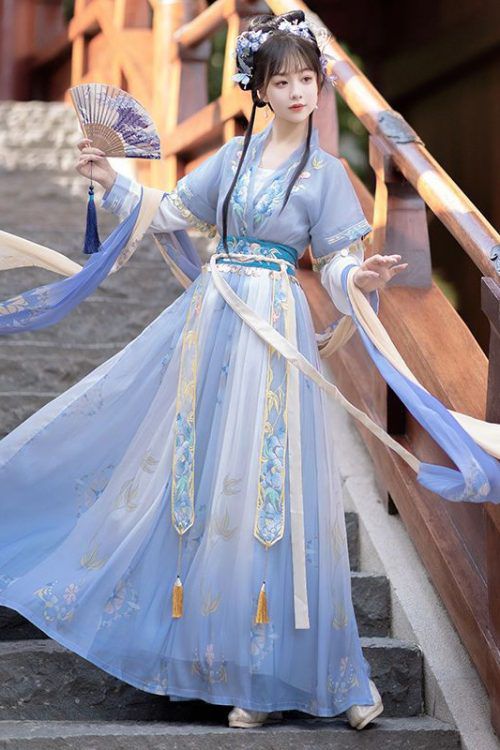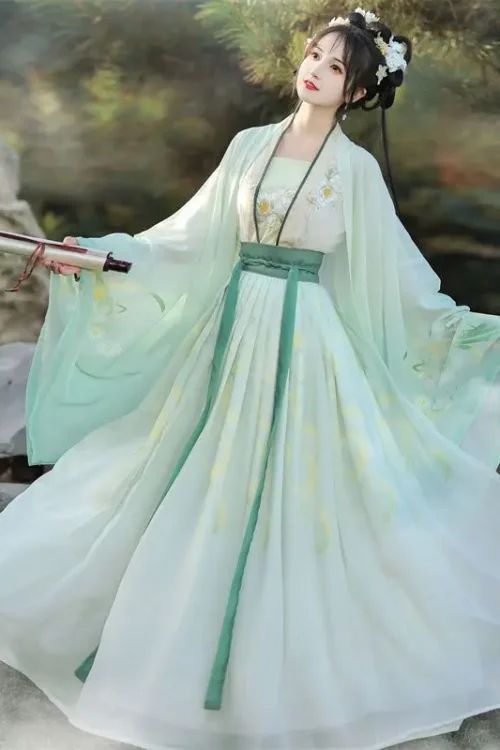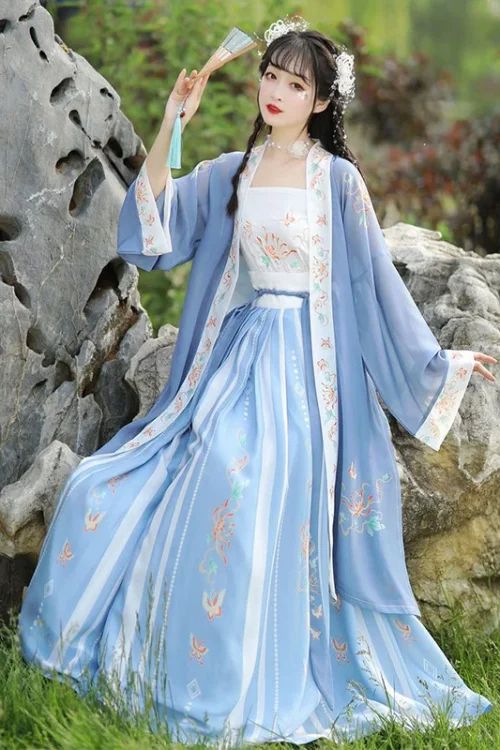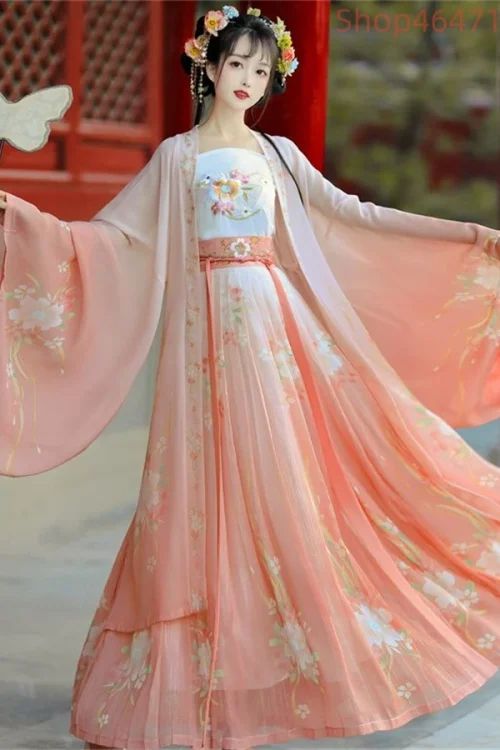The Flowing Elegance: Exploring the Cloud Pattern’s Influence on 汉服‘s Graceful Movement
Introduction to the Cloud Pattern in Hanfu
The cloud pattern, an iconic motif in Hanfu, China’s traditional clothing, has captivated the imagination for centuries. Its ethereal beauty and symbolic significance have inspired countless works of art, literature, and fashion. Beyond its aesthetic appeal, the cloud pattern holds a profound influence on Hanfu’s graceful movement.

Cloud Patterns and Graceful Movement
The cloud pattern’s flowing lines and swirling shapes evoke the movement of clouds in the sky. When incorporated into Hanfu, these patterns create a sense of lightness and fluidity. The fabric seems to dance and float around the wearer, enhancing the graceful movements of traditional Chinese dance and martial arts.
Symbolic Connection to the Divine
The cloud pattern’s association with the heavens and the divine further contributes to its inspiring effect. In Chinese culture, clouds are often seen as a bridge between the mortal and celestial realms. By incorporating cloud patterns into Hanfu, wearers can feel a connection to something greater than themselves, which can inspire confidence and a sense of purpose.
Versatility in Design
Moreover, the cloud pattern’s versatility allows for endless variations in design. From delicate wisps to bold, swirling clouds, the pattern can be adapted to suit different styles and personalities. This adaptability encourages creativity and self-expression, inspiring wearers to find their unique style within the rich tradition of Hanfu.

Influence Beyond Fashion
The cloud pattern’s influence extends beyond the realm of fashion. Its graceful movement has inspired countless works of art and literature. In paintings and sculptures, cloud patterns add a sense of dynamism and ethereal beauty. In poetry and prose, they evoke the boundless imagination and the ephemeral nature of life.
Conclusion: A Source of Inspiration
In conclusion, the cloud pattern on Hanfu is not merely a decorative element but a source of inspiration that has shaped the graceful movement of Hanfu for centuries. Its flowing lines, symbolic significance, and versatility have inspired countless works of art, literature, and fashion. By embracing the cloud pattern, wearers can connect with the heavens, express their creativity, and experience the transformative power of graceful movement.
Celestial Symbolism: Unraveling the Meaning Behind the Cloud Motif in Hanfu Design
Introduction to the Symbolism of Cloud Patterns
The cloud pattern, a ubiquitous motif in Hanfu design, holds profound cultural and symbolic significance. Its origins can be traced back to ancient Chinese cosmology, where clouds were revered as celestial beings that connected the heavens and the earth.

Symbolic Meanings of Cloud Patterns
In Hanfu, the cloud pattern represents the boundless expanse of the sky, symbolizing freedom, transcendence, and the pursuit of lofty ideals. It is often depicted in flowing, ethereal forms, evoking the graceful movement of clouds drifting through the heavens.
Auspicious Connotations
The cloud pattern also carries auspicious connotations. In Chinese folklore, clouds are associated with good fortune, prosperity, and divine protection. By incorporating the cloud motif into their garments, Hanfu wearers sought to attract these blessings into their lives.
A Reminder of Life’s Interconnectedness
Furthermore, the cloud pattern serves as a reminder of the interconnectedness of all things. Just as clouds gather and disperse, forming ever-changing patterns, so too do the fortunes of individuals and nations rise and fall. The cloud pattern thus encourages a sense of humility and acceptance of the cyclical nature of life.

Aesthetic Appeal of Cloud Patterns
Beyond its symbolic meaning, the cloud pattern also holds aesthetic appeal. Its intricate and fluid forms create a sense of movement and dynamism, adding a touch of elegance and sophistication to Hanfu designs. The cloud pattern can be rendered in various colors and techniques, from delicate embroidery to bold prints, allowing for a wide range of artistic expression.
Conclusion: Timeless Appeal
In conclusion, the cloud pattern on Hanfu is not merely a decorative element but a profound symbol that embodies the cultural, spiritual, and aesthetic values of ancient China. It represents the boundless expanse of the sky, the pursuit of lofty ideals, the interconnectedness of all things, and the enduring beauty of nature. As a timeless motif, the cloud pattern continues to inspire designers and fashion enthusiasts alike, bridging the gap between tradition and modernity.
Artistic Inspiration: How the Cloud Pattern Has Shaped Contemporary Fashion and Art
Introduction to Cloud Patterns in Contemporary Art
The cloud pattern, a ubiquitous motif in Hanfu, the traditional clothing of the Han Chinese, has captivated artists and designers for centuries. Its ethereal beauty and symbolic significance have inspired countless works of art and fashion, leaving an enduring legacy in contemporary culture.
Origins and Symbolism
The cloud pattern’s origins can be traced back to ancient Chinese mythology, where clouds were believed to be the abode of celestial beings. As such, the pattern became associated with divinity, power, and good fortune. In Hanfu, clouds were often depicted in flowing, swirling forms, evoking a sense of movement and fluidity.

Evolution into a Symbol of Elegance
Over time, the cloud pattern transcended its religious connotations and became a symbol of elegance and refinement. During the Tang Dynasty, it was particularly popular among the aristocracy, who adorned their garments with intricate cloud designs. The pattern’s popularity continued through subsequent dynasties, becoming an integral part of Chinese textile art.
Resurgence in 现代 Fashion
In the 20th century, the cloud pattern experienced a resurgence in popularity as Chinese artists and designers sought to revive traditional motifs. Contemporary fashion designers have incorporated the pattern into their collections, creating garments that blend traditional aesthetics with modern sensibilities. The cloud pattern has also found its way into other art forms, such as painting, sculpture, and jewelry.
Influence in Contemporary Art
One of the most striking examples of the cloud pattern’s influence in contemporary art is the work of Chinese artist Xu Bing. His installation “Cloud Gate,” a massive bronze sculpture in the shape of a cloud, has become an iconic landmark in Chicago’s Millennium Park. The sculpture’s fluid form and reflective surface create an ethereal and awe-inspiring experience for viewers.
Fashion and Haute Couture
Another notable example is the work of fashion designer Guo Pei. Her haute couture gowns often feature elaborate cloud patterns, rendered in exquisite fabrics and embellishments. Pei’s designs have been worn by celebrities and royalty alike, showcasing the enduring appeal of the cloud motif in contemporary fashion.
Conclusion: A Timeless Source of Inspiration
The cloud pattern’s versatility and timeless beauty have made it a source of inspiration for artists and designers across cultures. Its ability to evoke a sense of wonder, elegance, and divinity has ensured its continued relevance in contemporary art and fashion. As the world continues to embrace Chinese culture, the cloud pattern is poised to remain a powerful symbol of creativity and inspiration for generations to come.
Cloud pattern is the inspiration for designers. If you are interested in the traditional Chinese motifs including cloud pattern, you can have a look on our website:https://cheongsam.net/product-category/hanfu/, you will see the motifs with different styles on Hanfu.
